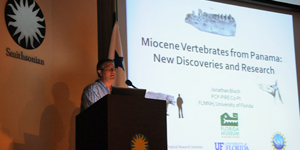by Luz Helena Oviedo
Were there camels in Panama? How does the Panama Canal expansion relate to paleontological discoveries? How is scientific information challenged by new data? All these questions and more were covered during the research session of the PCP-PIRE meeting. Attendees had the opportunity to see the project’s highlights for the first time in a one-day conference.

Very small and strange-looking camels, sea cows and tiny fossils of small vertebrates like bats and flying squirrels are among some of the most exciting discoveries in the fossil localities along the Panama Canal area. Jonathan Bloch (UF) and Gary Morgan (New Mexico Museum of Natural History) summarized vertebrate paleontology research. “We are still in the initial stages of documenting diversity,” mentioned Dr. Bloch during his talk.
Thanks to the Panama Canal expansion work and collaboration with Panama Canal Authority (ACP), it has been possible to collect information about ancient biodiversity and the geology of the isthmus. With access now possible to different sites, Camilo Montes (STRI) and David Farris (FSU) suggested a new age for the origin of the Panama isthmus (23-25 million years). This new model challenges the previous work done by Dr. Anthony Coates, who was the keynote speaker of the session. Dr. Coates showed his work in the Panama Paleontology Project (PPP), a predecessor of the PCP-PIRE which set the grounds for current and future research. Other PCP-PIRE research was presented by Carlos Jaramillo, David Foster and Austin Hendy.
During the poster session, participants were able to get an overview of more than 25 studies led by PCP-PIRE, STRI and Museo de Ciencias Naturales students and members. Participants had the opportunity to learn about a great variety of topics such as micropaleontology, paleobotany, vertebrate and invertebrate paleontology, geochronology, stratigraphy, Geographic Information Systems, ornithology, mammalogy and how humans impact disease transmission.
por Luz Helena Oviedo
Había camellos en Panamá? Qué tiene que ver la expansión del Canal con los descubrimientos paleontológicos? Cómo nuevos datos desafían la información científica? Estas preguntas y más, fueron cubiertas durante la sesión de investigación de la reunión del PCP-PIRE. Los asistentes tuvieron la oportunidad de ver los puntos más importantes del proyecto por primera vez en este día de conferencias.

Camellos pequeños de aspecto extraño, vacas marinas, fósiles diminutos de vertebrados pequeños como murciélagos y ardillas voladoras, son algunos de los descubrimientos más emocionantes encontrados en las localidades del área del Canal de Panamá. Jonathan Bloch (UF) y Gary Morgan (Museo de Historia Natural de Nuevo México) resumieron la investigación de paleontología de vertebrados. “Aún estamos en la etapa inicial de documentar la diversidad”, mencionó el Dr. Bloch durante su charla.
Gracias a la expansión del Canal de Panamá y a la colaboración con la Autoridad del Canal (ACP), ha sido posible colectar información sobre la biodiversidad del pasado y la geología del istmo. Con nuevas posibilidades de llegar a diferentes sitios, Camilo Montes (STRI) and David Farris (FSU) sugirieron una nueva edad para el origen del istmo de Panamá (23-25 millones de años). Este nuevo modelo desafía el trabajo previo realizado por el Dr. Anthony Coates, quien fue el orador que abrió el evento. El Dr. Coates mostró su trabajo en el Proyecto de Paleontología de Panamá (PPP), predecesor del PCP-PIRE, el cual preparo el terreno para la investigación actual y futura. Otras investigaciones del PCP-PIRE fueron presentadas por Carlos Jaramillo, David Foster y Austin Hendy.
Durante la sesión de posters, los participantes se llevaron una idea de más de 25 estudios liderados por estudiantes e integrantes del PCP-PIRE, STRI y Museo de Ciencias Naturales. Los participantes tuvieron la oportunidad de aprender sobre una gran variedad de temas como micropaleontología, paleobotánica, paleontología de vertebrados e invertebrados, geocronología, estratigrafía, Sistemas de Información Geográfica, ornitología, mastozoología y como los humanos impactan la transmisión de enfermedades.